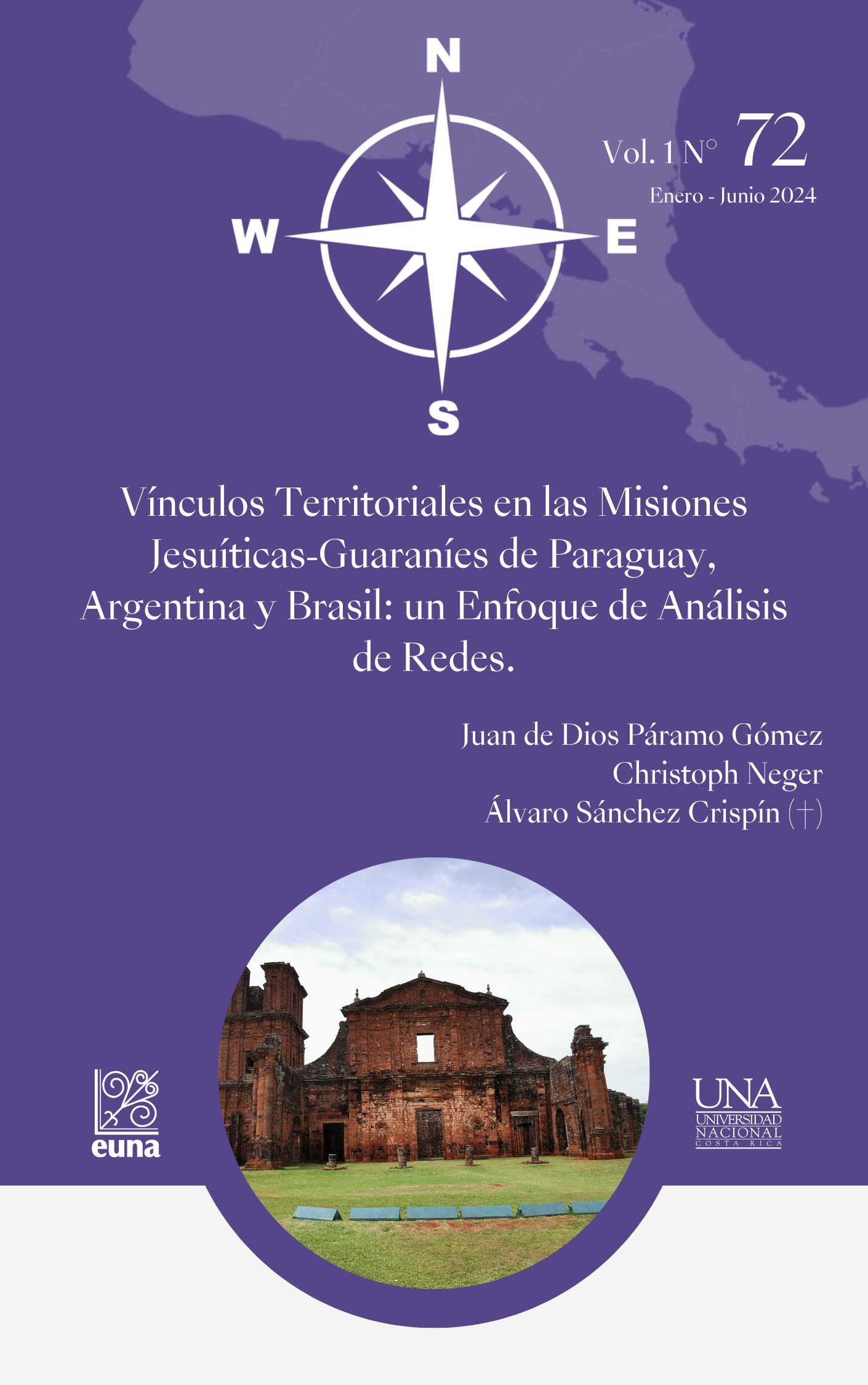Territorial Links in the Jesuitic-Guaranies Missions of Paraguay, Argentina, and Brazil: A Network Analysis Approach
DOI:
https://doi.org/10.15359/rgac.72-1.4Keywords:
spatial interaction, tourism, cultural heritage, tourist route, friction of spaceAbstract
Relationships and territorial links are fundamental to Geography studies. In recent years, these aspects have undergone significant evolution. Besides, the study of tourism activity is not indifferent since the flows generated in places of tourism interests are those that give rise to territorial dynamics. The main objective of this study is to reveal the spatial interactions stemming from an internationally renowned tourist route, with a very particular niche of its resources, which focus on the heritage of the Jesuit-Guarani missions located in three countries: Paraguay, Argentina, and Brazil. The methodology used integrates the use of qualitative and quantitative techniques. These techniques are combined with "Gephi," a network analysis software, and "Geographic Information Systems" (GIS). With the aid of cartography, the characteristics and properties of the nodes and links established among the “pueblos misionales" in which the primary tourist activities take place are displayed. Additionally, the concept of "friction of space" is incorporated to explain, in more detail, each of the relationships and links established.
References
Alvarado, I; Zamora, F; López, A. (2018). Representaciones espaciales, patrimonio y turismo: apuntes teórico-metodológicos. Revista de turismo y patrimonio cultural, (22), 27-57.
Andris, C. (2016). Integrating social network data into GISystems. International Journal of Geographical Information Science, 30(10), 2009-2031.
Ash, J; Kitchin, R; Leszczynski, A. (2016). Digital turn, digital geographies?. Progress in Human Geography, 42(1), 25-43.
Bosco, F. (2006). Actor-Network Theory, Networks, and Relational Geographies. Approaches to Human Geography: Philosophies, Theories, People and Practices. Sage, Londres, 150-162.
Carbonell, R; Blumers, T; Levinton, N. (2003). La reducción jesuítica de Santos Cosme y Damián. Su historia, su economía y su arquitectura (1633 – 1797). Fundación Paracuaria Missionsprokur SJ, Asunción, Paraguay.
Carbonell, R; Levinton, N. (2010). Un pueblo llamado Jesús. Fundación Paracuaria Missionsprokur SJ, Asunción, Paraguay.
Coe, N; Yeung, H. (2019). Global production networks: mapping recent conceptual developments. Journal of Economic Geography, 19(4), 775-801.
Colina, C; Roldán, P; Bolíbar, M & Muntanyola, D (2013). La centralidad en las redes sociales: medición, correlación y aplicación. Metodología de Encuestas, 15, 77-97.
Dalcim, I. (2011). Breve História das reduções jesuítico-guaranis. Edições Loyola. São Paulo.
Daraganova, G; Pattison, P., Koskinen, J., Mitchell, B., Bill, A., Watts, M., & Baum, S. (2012). Networks and geography: Modelling community network structures as the outcome of both spatial and network processes. Social Networks, (34), 6-17.
De Grande, P; Eguía, M. (2008). Reconstruyendo la rede de lazos personales, Metodología egocéntrica para la investigación sociocéntrica. REDES. Revista hispana para el análisis de redes sociales, 15(9), 116-123.
De la Rosa, F; Gasca, R., Abril, L & Morente, F. (2005). Análisis de Redes Sociales mediante diagramas estratégicos y diagramas estructurales. REDES. Revista hispana para el análisis de redes sociales, 8(2), 1-34.
Ducruet, C. (2017). Graph Theory. The International Encyclopedia of Geography, Wiley-Blackwell and Association of American Geographers.
Flores, M. (1986). Colonialismo e Missões Jesuíticas. Instituto de Cultura Hispânica, Brasil.
Fotheringham, S. (1981). Spatial structure and distance-decay parameters. Annals of the Association of American Geographers, 71(3), 425-436.
Fotheringham, S. (1983). A new set of spatial-interaction models: the theory of competing destinations. Environment and Planning, 15(1), 15-36.
Funk, R. (2014). Making the most of where you are: geography, networks, and innovation in organizations. Academy of Management Journal, 57(1), 193-222.
Gregory, D (2009). The Dictionary of Human Geography. Quinta edición. Wiley-Blackwell.
Gutiérrez, J. (1998). Redes, espacio y tiempo. Anales de Geografía de la Universidad Complutense, (18), 65-86.
Humberstone, J; Álvarez, F. (2019). Análisis de redes sociales: Identificación de comunidades virtuales en Twitter. Realidad y Reflexión, 19(50), 70-81.
Jackson, R. (2008). The population and vital rates of Jesuitic Missions of Paraguay 1700 - 1767. Journal Interdisciplinary History, 38(3), 401-431.
Kelman, I; Luthe, T., Wyss, R., Tørnblad, S., Evers, Y., Curran, M. & Berlow, E. (2016). Social Network Analysis and Qualitative Interviews for Assessing Geographic Characteristics of Tourism Business Networks. PLOS ONE, 11(6), 1-14
Kuz, A; Falco, M: Giandini, R. (2016). Análisis de redes sociales: un caso práctico. Computación y Sistemas, 20(1), 89-106.
Levinton, N; Snihur, E. (2011). El porvenir de Misiones. Entidad Binacional. Contratiempo Ediciones. Argentina.
Lugon, C. (2010). A República Guarani. Editora Expressão Popular. Brasil.
Maldavsky, A; Wilde, G. (2014). Paradojas de la ausencia. Las misiones jesuíticas sudamericanas y el imaginario posterior a la restauración en Las Misiones antes y después de la restauración de la Compañía de Jesús: continuidades y cambios [Tesis, Universidad Iberoamericana Ciudad de México; Pontificia Universidad Javeriana].
McNaspy, C. (1998). Una visita a las ruinas Jesuíticas. Asunción, Paraguay.
Neger, C; Propin, E. (2018). Regional Ecotourism Networks: Experiences and Lessons from Los Tuxtlas, Mexico. Mitteilungen der Österreichischen Geographischen Gesellschaft, (160), 143-162.
Neger, C. (2021). Configuración territorial de los actores sociales involucrados en la gestión del fuego en la sierra de Los Tuxtlas (México). Boletín de la Asociación de Geógrafos Españoles, (90).
Nilson, A. (1986). Retrato sem Retoque das Missões Guaranis. Brasil.
Páramo, J. (2020). Contexto territorial del turismo en las ruinas jesuíticas de Itapúa, Paraguay en Arreglo territorial del turismo en América Latina. Casos de México, Costa Rica y Paraguay. Instituto de Geografía UNAM, 165 - 185.
Pineda, O. (2016). Los guaraníes, los Jesuitas y las misiones en el Paraguay. Editorial Servilibro. Paraguay.
Pineda, O. (2017). Breve Historia integral del Paraguay. Desde los pueblos originarios hasta la presidencia de Horacio Cartes. Editorial Servilibro. Paraguay.
Quevedo, J. (1993). As Missões. Crise e redefinição. Editora ática. Brasil.
Quintero, J; Sánchez, A. (2018). Fricción del espacio y externalidades territoriales de la movilidad turística terrestre en América Central. PASOS. Revista de Turismo y Patrimonio Cultural, 16(49).
Rodrigue, J. (2020). The Geography of Transport Systems. Fifth Edition, Routledge, New York.
Rosas, L; Propin, E. (2022). Interacciones espaciales asociadas con el culto al Cristo Mojado en Los Ángeles, California, Estados Unidos. Revista Geográfica de América Central, 1(68).
Sarkar, D; et al. (2019). Metrics for characterizing network structure and node importance in Spatial Social Networks. International Journal of Geographical Information Science, 33(5), 1017-1039.
Telesca, I. (2010). La Provincia del Paraguay, revolución y transformación 1680 – 1780. El Lector. Paraguay.
Ter Wal, A; Boschma, R. (2009). Applying social network analysis in economic geography: framing some key analytic issues. The Annals of Regional Science, 43(3), 739-756.
Trento, A. (2001). Reduzioni Gesuitiche. Il cristianesimo felice. Editorial San Rafael.
Ullman, E. (1980). Geography as spatial interaction. University of Washington Press.
Villalba, C. (2019). Arte Jesuítico. FONDEC, Paraguay.
Wilson, A. (1971). A family of spatial interaction models, and associated developments. Environment and Planning, 3(1), 1-32.
Yubi, J. (2013). Pueblos Jesuíticos del Paraguay. Editorial Servilibro. Paraguay.
Zeppel, H; Hall, H. (1991). Selling, Art and History: Cultural Heritage and Tourism. The Journal of Tourism, 1(2), 29-45.

Published
How to Cite
Issue
Section
License
Copyright (c) 2024 Juan de Dios Páramo Gómez

This work is licensed under a Creative Commons Attribution-NonCommercial-ShareAlike 4.0 International License.
Proposed policy for journals offering Open Access
Authors publishing their works in the Journal acknowledge and agree to the following terms:
a) Authors retain the copyrights to their works and guarantee the Journal the right to be the first to publish their works, under the Creative Commons License Attribution-NonCommercial-ShareAlike 4.0 International, CC BY-NC-SA 4.0 International (https://creativecommons.org/licenses/by-nc-sa/4.0/deed.es), which allows others to share works upon complying with the acknowledgment of authorship and mention of the Journal as the original publisher of the work.
b) Authors are permitted to separately establish additional agreements for the non-exclusive distribution of the official edition of the work published in the Journal (for example, authors may desire to place the work in an institutional repository or incorporate it into a book that is to published elsewhere) so long they acknowledgment to recognize the Journal as the original publisher. The aforementioned additional agreements must respect the terms of the non-profit character and sharing philosophy of the original license (CC BY-NC-SA 4.0 International, https://creativecommons.org/licenses/by-nc-sa/4.0/deed.es).
c) Authors are encouraged to archive the post-print or editor/PDF version in Open Access repositories.






 REVGEO is licensed under https://creativecommons.org/licenses/by-nc-sa/4.0/deed.es
REVGEO is licensed under https://creativecommons.org/licenses/by-nc-sa/4.0/deed.es
.svg_4.png)

_(1).png)
_(1)_(1)_(1)_1.png)
(2)(1)(1)(1).png)
